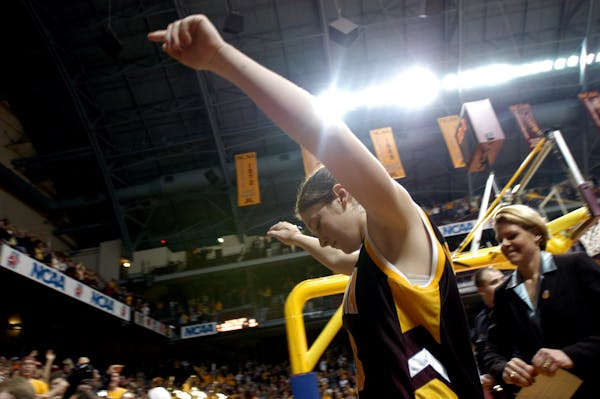Tuesday at Target Center, in an hour-long presentation emceed by Rebecca Lobo, just about everyone associated with the Women's Final Four showed up to promote an event that will be there in fewer than 40 days.
That included NCAA officials, members of the local women's basketball community, the local organizing committee, Gophers officials and Minneapolis Mayor Jacob Frey, among many, many others.
And if there was one theme to the proceedings, it was this:
Equality.
It's been almost a year since a light was shone on the NCAA — with much of it coming from student-athletes on social media — for the inequity with which the men's and women's tournaments were run. It started with pictures of the women's weight room, a rack of dumbbells, contrasted with the full weight room provided the men. There were questions about the food served, the gift bags provided.
It was a harsh light. A law firm was engaged to study the problem. NCAA president Mark Emmert apologized.
But if you ask Lynn Holzman, that harsh light came with a silver lining — action.
"It got things done, didn't it?" Holzman asked Tuesday. She is the NCAA's vice present of women's basketball. "I think when you talk about embracing the opportunity, really that's what happened.
"Not just those who have been fighting for these enhancements and improvements, but others were brought into the movement, if you will, by the media coverage, by the social media by our student athletes and coaches.''
It's been nearly a year. But when this year's tournament begins the process of culling 68 teams to the four who will come here to play in the national semifinals April 1, it appears much progress has been made to make this a more equitable event — for the athletes and the fans.
Tourney enhancements
Start with the 68-team field, up from 64 last year, putting the women's tournament on a par with the men's.
"Several years ago the men's went to 68,'' said Nina King, Duke's athletics director and chair of the NCAA's women's selection committee. "We have the same number of Division I women's teams as men's teams. It's about creating participation opportunities.''
Or the fact that, for the second year, every game in the tournament will be available on one of ESPN's platforms. ESPN will have an array of technological advancements you'll see when the Women's Final Four starts.
The network will install 40 cameras around Target Center, according to ESPN's coordinating producer Patricia Lowry. A typical televised game has five cameras, she said.
The Women's Final Four will have a rail cam that will move up and down the sidelines to give a sense for the speed of the game, high-speed cameras in the corners and a camera that will be aloft in Target Center showing the action from above.
For the fans? Wendy Blackshaw, CEO of Minnesota Sports and Events, went down the list: Tourney Town, a three-day fan festival at the convention center; Beyond the Baseline, featuring panel discussions; Party on the Plaza, which will run in First Avenue from Friday through Sunday; an open practice for the final two teams on Saturday at Target Center, and a concert Saturday night.
All free and open to the public.
To Frey, having an event like this come to Minneapolis, which may be on the verge of opening back up after a two-year Covid-19 shuttering, is perfect timing.
"It's a major deal,'' Frey said. "This gives us the shot in the arm we need, a boost of energy to have a downtown that is bustling, coming back after a couple years' hiatus.''
Historic adjustments
Holzman knows inequity first-hand, having experienced it as a basketball player at Kansas State and later as an administrator. You get the sense talking with her that working for change had, at times, been frustratingly slow. But after the events of last year? She described the whirlwind of coverage acting like a catapult for change.
"What this last year has entailed is a lot of work, a lot of time being spent by both the NCAA staff and the men's and women's basketball committees, analyzing and scrutinizing every part of the championship. I don't think, historically, that had ever been done before in the history of the NCAA.''
It was an opportunity.
"It's been 40 years of the NCAA having this championship,'' she said. "It's the 50th anniversary of Title IX. … This really was the moment of time to embrace, and really take advantage, of the opportunity to really do some things around this championship.''




